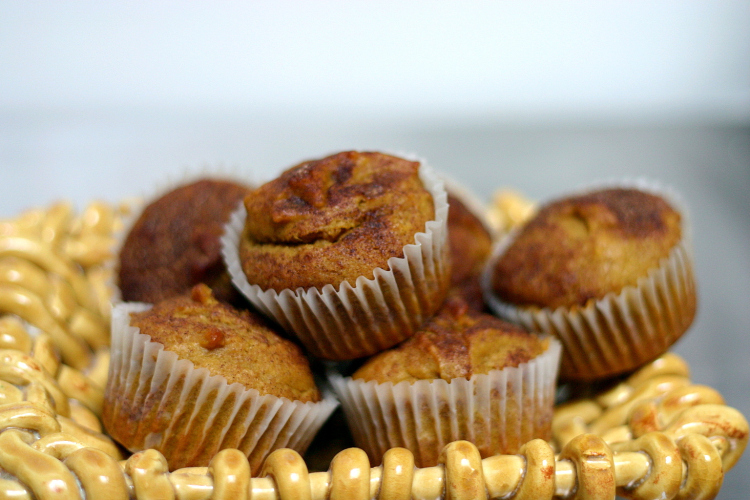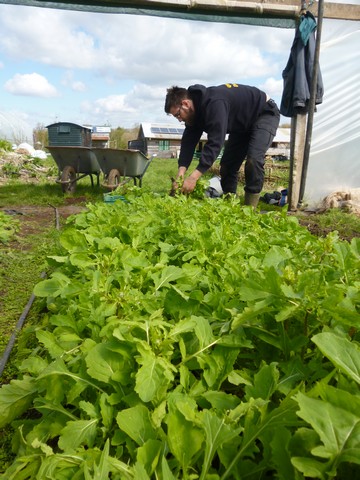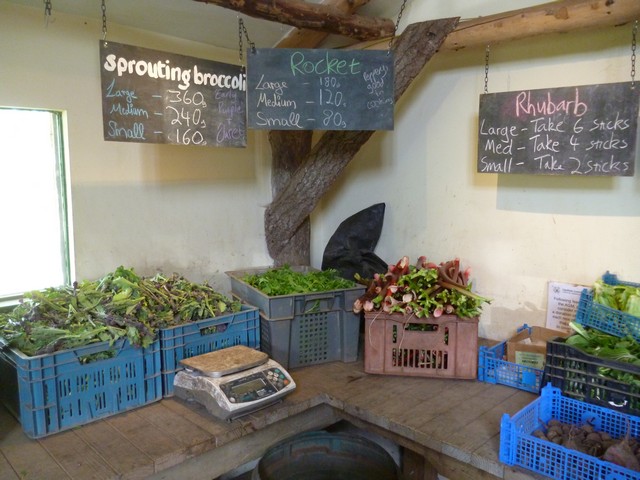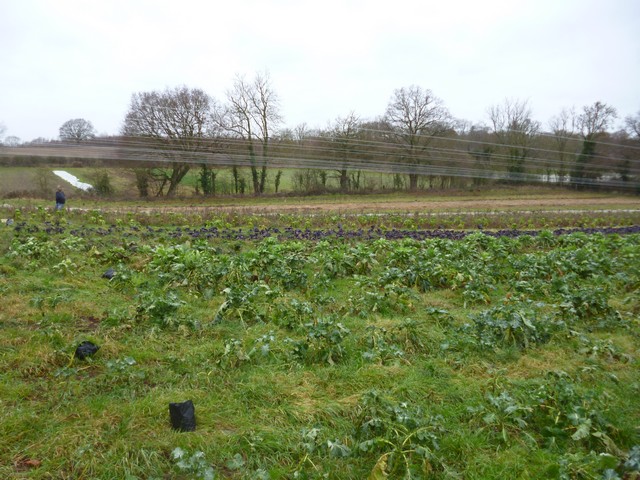Rebecca’s Recipe of the Week: Rye Bread with Radish Butter and Salmon Caviar
‘Peppery, earthy, salty: a good way to whet the appetite’, writes Diana Henry. These little nibbles make a splendid start to a dinner. The radish butter keeps in the freezer for ages. You could certainly use it under other smoked fish, or on its own as a sandwich butter.
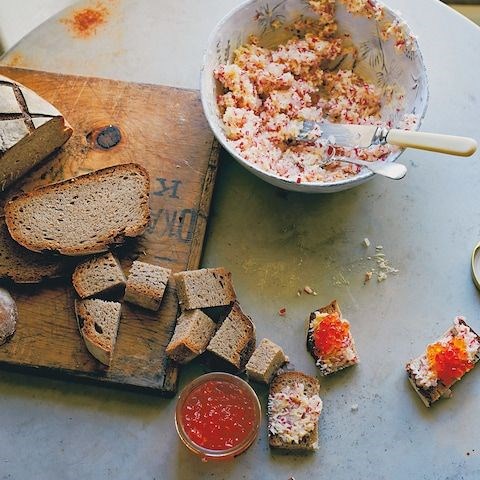
Rye Bread with Radish Butter and Salmon Caviar
Serves 4
Ingredients
125g radishes
60g unsalted butter, softened
¼ sea salt
Freshly-ground black pepper, to taste
½ loaf of dense rye bread
50g red lumpfish or salmon caviar
2 tablespoons fresh chives, minced
Preparation
Put the radishes in the bowl of a food processor and pulse 4-5 times until chopped into very fine dice. Transfer to a piece of muslin and wring out as much of the excess liquid as you can with your hands.
Tip into a bowl and add the butter, salt and pepper. Blend together with a rubber spatula until the mixture is well-combined.
Slice the bread into thin slices. Spread with radish butter and top with a spoonful of the lumpfish. Top with a sprinkling of fresh chives and a further grind of pepper.
Recipe adapted from Diana Henry, How to Eat a Peach (2018).
Rebecca’s Recipe of the Week: Spicy Coconut Cauliflower
Cumin-scented cauliflower, yellow from turmeric, cooks with Canalside chile and a subtle coconut-poppy seed glaze. The result is spicy, satisfying and beautiful. Eat it topped with toasted almonds, fresh coriander, yoghurt and a squeeze of lime. Yotam recommends serving with flatbread, but it’s pretty delicious just on its own.
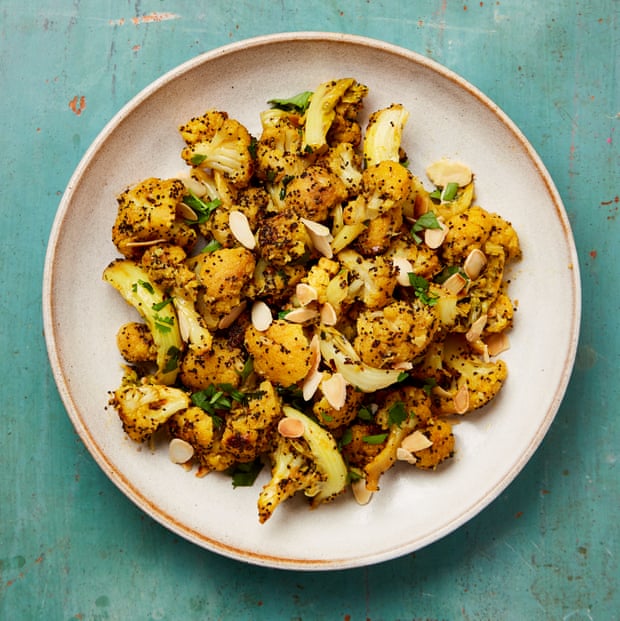
Poppy-Seed Cauliflower with Coconut
Serves 2
Ingredients
40g poppy seeds
60ml sunflower oil
½ – 1 Canalside dried red chile, de-seeded if desired, and shredded
1 teaspoon turmeric
1 teaspoon cumin seeds
2 garlic cloves, peeled and sliced fine
1 large cauliflower and leaves, broken into 4cm-sized florets, leaves shredded
150ml coconut milk (approx.)
To serve
1 handful fresh coriander, shredded
1 small handful flaked almonds, lightly toasted in a dry pan
plain yoghurt
1 lime, halved
Preparation
Put the poppy seeds in a small bowl. Pour over just enough boiling water to cover them. Leave them for half an hour, and then whiz them in a blender or food processor, or crush them in a mortar and pestle, so that they begin to break up a bit. Set aside.
Heat the oil over medium-high heat in a large sauté pan for which you have a lid. When it is hot add the chile, turmeric, cumin and garlic. Turn the heat to medium and sauté for 4 minutes, stirring often, until the garlic starts to brown and the mixture gives off a nice smell.
Add the cauliflower leaves and florets and toss with the spices. Stir for 2 minutes, until the cauliflower has turned an attractive yellow.
Add the coconut milk and the poppy seeds. Add enough coconut milk to make a little sauce, but not so much that it is soupy. Turn the heat down a little and cover. Cook for 4 more minutes, until the cauliflower has begun to soften.
Uncover and turn the heat up to medium-high. Cook for 8 more minutes, stirring regularly, until the cauliflower is tender and has begun to caramelise and the liquid has evaporated.
Serve topped with fresh coriander, toasted almonds, yoghurt and a squeeze of lime.
Recipe adapted from Yotam Ottolenghi, The Guardian, 16 Feb. 2019.
Rebecca’s Recipe of the Week: Carrot-Nut Porridge
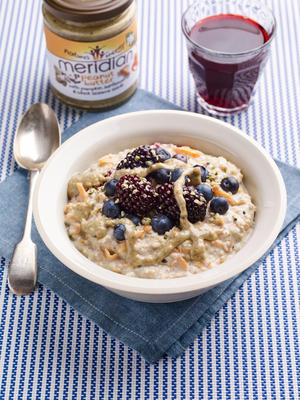
I was recently at an event where everyone was asked what they had for breakfast. 8 of the 10 people replied ‘porridge’. Clearly porridge is having a bit of a moment. Here is a surprising, satisfying and toothsome variant. Cooked with oat milk, shredded carrot becomes soft and sweet, blending perfectly with the oats to make a rich, thick breakfast. The peanut butter, berries and hemp hearts add further sweetness, depth and crunch.
Carrot-Nut Porridge
Serves 2
Ingredients
100g porridge oats
100g carrot, peeled and shredded
600ml oat milk
¼ teaspoon grated nutmeg
2cm vanilla pod
2 tablespoons crunchy peanut butter
Blueberries or blackberries, to serve (frozen are fine)
2 tablespoons hulled hemp seeds, to serve
2 tablespoons date syrup, mulberry syrup, maple syrup or honey, to serve (if desired)
Preparation
Place the oats, shredded carrot, oat milk, nutmeg and vanilla pod in a saucepan and bring slowly to a simmer. Simmer for 8-10 minutes, or until it’s thick and the carrot is soft. Stir in the peanut butter.
Divide into two serving bowls and top with berries and hemp seeds, and drizzle with syrup to taste.
Recipe adapted from Meridian Foods.
2019 – April news: A Time To Freeze
We are deep in the spring glut, that abundant period when leafy greens in particular grow faster that we can cut them. Leaves are most prolific in spring and autumn, with demand outstripping supply at other times of year! It’s an ideal time for blanching and freezing some ready for use later in the year – we’re heading towards the leaner spell in May and June when some veg in hand will be a bonus. Spinach, chard, spring greens, kale and purple sprouting broccoli are all good contenders for this.
Ali’s Recipe of the Week: One for the Store-cupboard
Rebecca’s having a break this week and hopes to be back with another recipe next week.
With the cauliflower crop getting going, the moment may have arrived to do the first preserving of the year (that is, if you haven’t already made marmalade, perhaps using some delicious La Jimena seville oranges).
Piccalilli is as versatile as any savoury preserve in that you can flex the recipe according to what is available. Most piccalilli recipes call for courgettes, green beans, tomatoes, and other summer veg. However, if all you have is roots and PSB (purple sprouting broccoli) that combination will also make a perfectly good version of this tangy preserve. Luckily my book of preserves from the Women’s Institute can oblige with a suitably flexible recipe for any time of year! I’ve been know to make a version with cauliflower, onions (admittedly these are perhaps the two essential vegetables), carrot and swede!
Many piccalilli recipes call for the vegetables to be brined overnight, but this one breaks that rule, which simplifies the recipe and results in a delicious accompaniment for a ploughman’s lunch. And unlike chutneys which rely on evaporation of the liquid to thicken the preserve (which can sometimes take hours), as this one is thickened with flour it has a much shorter cooking time.
Accommodating Piccalilli from the W.I.
Makes about 2.7kg (6lb) = 6 average sized jam jars
Preparation time: 45 minutes
Cooking time: 30 minutes
Ingredients
1 large cauliflower, broken into florets
450g (1lb) pickling onions – if you’ve still got any little Canalside onions left, they’d be perfect!
1.4L (2 1/2 pints) white malt vinegar (apple cider vinegar also works well)
900g (2lb) mixed vegetables, diced or cut into 2.5cm (1 inch) lengths
2 fat cloves of garlic
450g (1lb) caster sugar
50g (2oz) dry mustard (i.e. mustard powder)
115g (4oz) plain white flour, sieved
25g (1oz) ground turmeric
1 tsp ground coriander
2 tsp salt
Preparation
In a large preserving pan, summer the cauliflower and onions in 1.1litres (2 pints) of the vinegar for 10 minutes.
Add the other vegetables, garlic and sugar and cook for a further 10 minutes.
Mix the mustard, flour. spices and salt with the remaining vinegar and add to the cooked vegetables, stirring all the time to prevent lumps from forming.
Stir well and simmer for a further 10 minutes.
Spoon into cooled and sterilised jars and cover with vinegar proof tops. Label and store for at least 2 weeks before using. It will keep for months (I think I’ve even kept it for more than a year) with the flavour improving and mellowing as it ages.
From ‘Best Kept Secrets of the Women’s Institute: Jams, Pickles and Preserves’ by Midge Thomas
Rebecca’s Recipe of the Week: Sprouting Broccoli
A fresh green plate of spring broccoli, lemony parsley sauce and the unctuousness of soft egg yolk. Dried chile pepper adds a touch of red and extra bite to this easy mid-week dinner. Serve with toast, or a little rice.
Sprouting Broccoli with Parsley and Poached Egg
Serves 2
Ingredients
20g parsley
¼ cup olive oil
Juice of ½ lemon
Salt and pepper to taste
300g sprouting broccoli, ends trimmed and cut into similarly-sized lengths
2 eggs
Greek yoghurt, to serve
1 dried red chile, seeds removed, shredded (if desired)
Preparation
Remove any tough stems from the parsley. Whizz it together with the oil and lemon juice in a food processor or immersion blender until it makes a thick green purée. Season to taste with salt and pepper. It should be fresh and lemony. Add more oil or lemon juice until you’re happy with it.
Bring a pot of water to the boil and cook the sprouting broccoli until it’s tender, about 8 minutes. Fish out the broccoli and keep it warm, leaving the water in the pan. You’ll use it to poach the egg.
Add more water to the pan if necessary and bring it to a low simmer. Add a splash of white vinegar if you like (this helps the egg to retain a reasonably nice shape), and then crack the eggs one at a time into the water. Poach over low heat for about 2 minutes, or until the whites are set. Turn off the heat and leave the eggs in the pan while you plate up.
Arrange the broccoli onto two dinner plates. Spoon most of the parsley sauce artfully over the broccoli and around the plate. Top each mound of broccoli with a poached egg and decorate that with the remaining parsley sauce. Dot the broccoli and egg with several spoonfuls of Greek yoghurt and strew a little of the red chile pepper over the top—but watch out: the Canalside chiles are really potent! Grind a final sprinkle of black pepper over the top.
Rebecca’s Recipe of the Week: Another Great Cocktail
Good cocktails are greater than the sum of their parts. This one has a lot of parts, but nonetheless manages to exceed them, to produce a subtle and effective drink that will cure what ails you. If you were wondering what to do with all the citrus you’ve acquired in your La Jimena box, here is one suggestion. Rose, orange, mint, and cinnamon combine in a liquid homage to the flavours of Morocco. It’s worth seeking out some rose liqueur; the Edinburgh Gin Company make a very acceptable pomegranate and rose gin liqueur which works well, or you can use Briottet Liqueur de Rose. In either case, give this one a try.
Lost in Marrakech
Serves 1
Ingredients
3-4 wide curls of orange peel
15 mint leaves
40ml white rum or cachaça
10ml rose liqueur
2 drops orange flower water
20ml orange juice
15ml lemon juice
15ml lime juice
25ml cinnamon simple syrup (see below)
2-3 drops Angostura bitters
rose petals (to garnish, optional—but Neil’s Yard sells these loose and they look very pretty. . . )
more fresh mint (to garnish)
Preparation
Combine the orange peel and mint leaves in a lowball glass. Crush them a bit to release the flavours, and then add some ice.
Pour in the rum, rose liqueur and orange flower water. Stir.
Blend the citrus juices and cinnamon syrup and add to the glass. Stir again.
Shake a few drops of Angostura bitters over the top, and decorate with rose petals and a bit more mint.
Drink thinking of distant locations far from our troubled isle.
Cinnamon simple syrup
Ingredients
1 cup water
1 cup sugar
1 cinnamon stick
Preparation
Combine water and sugar in a small saucepan and bring slowly to the boil. Simmer gently until the sugar is dissolved—about 5 minutes. Add the cinnamon stick, and then decant into a glass jar or other container. Let cool, and refrigerate for at least 24 hours to allow the flavours to blend. This keeps indefinitely in the fridge.
Recipe adapted from Dav Eames, in The Guardian.
2019 – March news: Potatoes Planted
On Thursday the growers took advantage of the sublime spring sunshine and got our 3/4 acre of potatoes planted! This is nearly a month earlier than last year, which highlights the contrast between super-sodden March 2018 and the super-sunny one this time around. We have a large surplus of a red variety called Robinta which will be available for members to take for free, though the tubers are on the small side.
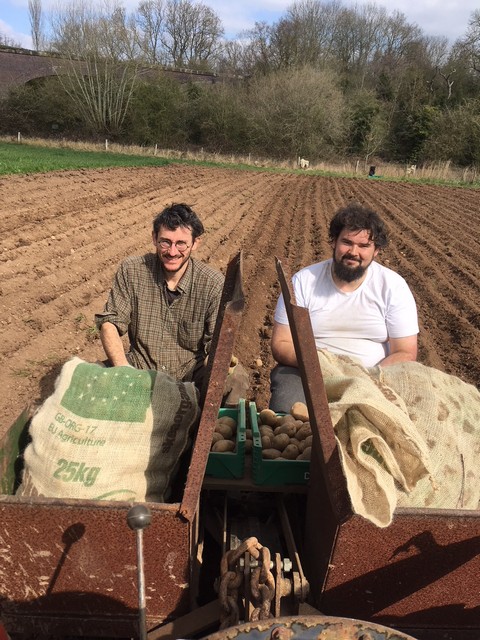
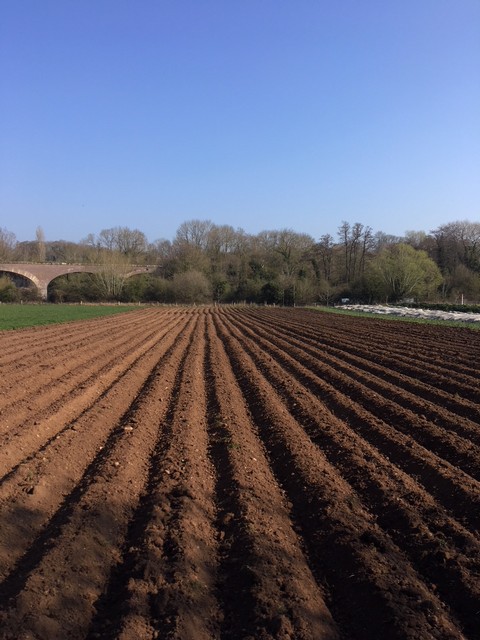
In other news our onion sets have beaten Brexit: they arrived from Holland despite warnings from the suppliers of Brexit-related delays! So we are all ready for the Onion Planting Day/Members’ Social on April 6th. It’s a great activity to kick-start the growing season for kids and adults alike, with a bring and share lunch to boot!
Rebecca’s Recipe of the Week: The Cocktail You Need
If you’ve just taken receipt of a box of citrus from La Jimena then you’re ideally placed to make this superb cocktail. Like all great cocktails, it is greater than the sum of its parts.
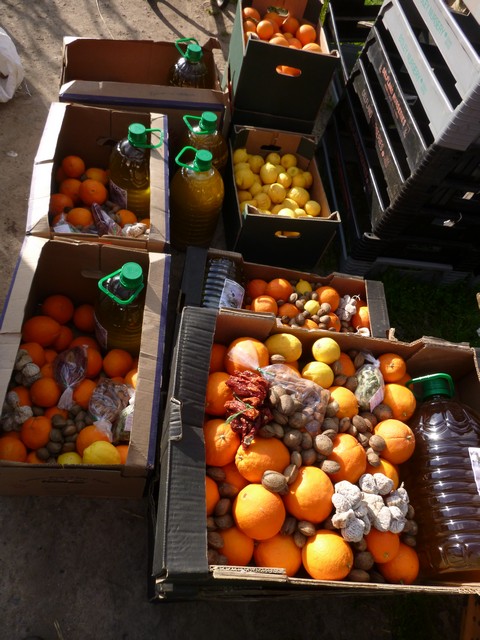
Trainwreck
Serves 2
Ingredients
3 parts fresh orange juice (ideally, blood orange juice)—start with one orange.
2 parts rye
1 part campari
1 part sugar syrup
2 slices of orange, for garnish
Preparation
Fill two lowball glasses with ice. Stir the ingredients together in a measuring jug and pour into the prepared glasses. Garnish each with an orange slice and enjoy.
One medium orange should provide enough juice for two cocktails. Then you can measure the other ingredients in proportion: use a third as much campari and sugar syrup, and 2/3 as much rye.
Rebecca’s Recipe of the Week: Bobbie Griffith’s Pumpkin Muffins
Bobbie Griffith was, I think, my second cousin twice removed, or something like that. Anyway, she lived in Wisconsin and this is her recipe for pumpkin muffins. They’re spicy and comforting, and easy.
Shaker Style Pumpkin Muffins
Makes 12
Ingredients
2/3 cup soft brown sugar, packed into the cup
¼ cup treacle
½ cup butter at room temperature
2 eggs
1 cup pumpkin purée (see below)
1½ cups plain flour
¼ cup oat bran (or use 1¾ cups plain flour)
1 teaspoon bicarbonate of soda
¼ teaspoon salt
½ teaspoon cinnamon
¼ teaspoon ground cloves
¼ teaspoon ground nutmeg
Preparation
Preheat the oven to 180. Butter a 12-cup muffin tin, or line with paper muffin cases.
Cream the sugar, treacle and butter together until very light and fluffy. If you use an electric mixer you can leave it to do its work for as long as five minutes if you like. Add the eggs and pumpkin and blend well.
Combine the flour, oat bran (if using), bicarbonate of soda, salt and spices and mix well.
Add the dry ingredients to the pumpkin batter and mix only until blended—don’t overbeat.
Spoon the batter into the muffin tins and bake for 20 to 25 minutes or until a toothpick comes out dry when inserted into the centre of a muffin. Let cool a little before eating.
To make puréed pumpkin or squash
Preheat the oven to 190.
Slice your pumpkin into large wedges and remove the seeds. Place it on a baking sheet and roast until it’s cooked and tender throughout. Depending on the size of the wedges this should take between 15-30 minutes. Peel the squash and mash or purée with a hand blender until smooth. You can freeze any extra.
